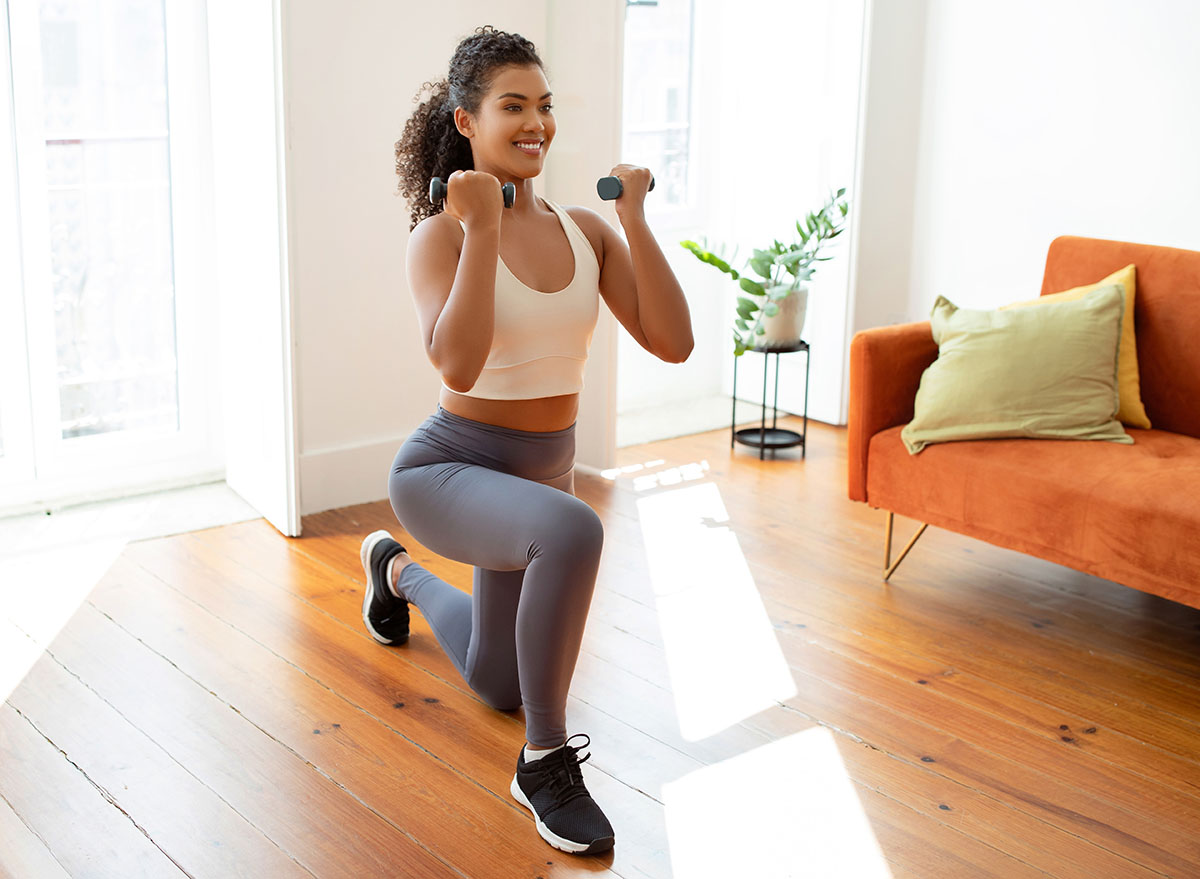5 Standing Exercises That Burn More Calories Than Running After 50

Road and treadmill running is a go-to calorie burner for many fitness enthusiasts. This high-intensity, total-body workout revs up your heart rate and fires up many muscle groups at the same time generating a solid calorie burn while you’re running—and even after you’ve finished. But if you’re looking to switch things up or running isn’t an option, consider these five standing exercises. They can torch even more calories than running after you hit 50—and you may even enjoy weaving them into your routine!
“The problem with running as a means of simply burning calories, is that once you stop running, you’ve effectively stopped the caloric expenditure,” explains Kevin Snodgrass, head trainer at Vivo. “Alternatively, strength training burns calories during the activity, and you get the added benefit of a higher metabolic output for 24 to 48 hours after as your body repairs from the workout. Strength training also has numerous other benefits from increased muscle mass and improved bone density, to better cognitive health. Compared to running, strength training will always be preferred.”
Snodgrass recommends prioritizing full-body strength exercises that recruit major muscle groups—the back, chest, glutes, quads, and hamstrings.
“The more muscle recruited, and the heavier the weight being moved, the higher the calorie burn,” he says.
Perform the below exercises two times a week for beginners and three times a week for active, more advanced fitness enthusiasts.
Weighted Squats
Squats fire up large muscle groups—including the hamstrings, glutes, quads, and core—which helps rev up the calorie burn. Adding weights like dumbbells or kettlebells into the mix also gives your arms a stellar workout as well.
- Begin by standing tall with your feet shoulder-width apart.
- Hold a dumbbell, kettlebell, or weight plate in front of your chest. Snodgrass recommends choosing a weight that makes 8 reps feel challenging.
- Bend at the knees and hips as you lower into a squat.
- Use control to descend until your thighs assume a “sitting” position or lower.
- Press through your heels to return to standing.
- Perform 3 sets of 8 reps.
RELATED: Over 50? If You Can Do This Many Knee Pushups, Your Upper Body Is Stronger Than Most
Weighted Deadlifts
Weighted deadlifts are an excellent choice to help strengthen your posterior chain while boosting flexibility and balance. It trains the hamstrings, glutes, back, arms, and core.
- Begin by standing tall with your feet hip-width apart, holding a heavy dumbbell in each hand in front of your thighs. Snodgrass recommends choosing a weight that makes 8 reps feel challenging.
- Make sure your legs are mostly straight with just a slight bend in the knees.
- Hinge at the hips to lower the dumbbells down your legs and toward the floor.
- Keep your back flat and the dumbbells close to your body when lowering, feeling a solid stretch in the hamstrings.
- Activate your glutes and hamstrings as you rise back up.
- Perform the exercise for 3 sets of 8 reps.
Weighted Thrusters
“Weighted thrusters work the whole body. The thruster is a combo movement that starts with a squat and finishes with an overhead press,” Snodgrass explains. “From a standing position, [you’ll] hold two weights at your shoulders, squat to the height of a chair, then stand up. As you stand up, press the weights overhead, then bring them back to your shoulders and repeat.”
- Stand tall with your feet shoulder-distance apart.
- Hold a dumbbell in each hand at shoulder level, palms facing inward. Snodgrass recommends using a light to moderate weight.
- Bend your knees and press your hips back to lower into a squat.
- Drive through your heels, exploding out of the squat as you extend your legs and press the dumbbells overhead in a smooth motion.
- Lower the weights to shoulder height.
- Return to a squat.
- Complete 3 sets of 8 reps.
Weighted Lunge to Curl
The weighted lunge to bicep curl is an awesome total-body combo move that fires up the legs and arms. How to do it? You’ll hold two dumbbells at your sides, step back into a reverse lunge, lower, and then curl the weights up to your shoulders before rising back up.
- Begin by standing tall, holding a dumbbell in each hand at your sides. Snodgrass recommends using a light to moderate weight.
- Take a big step back with your right leg, dropping your right knee toward the floor.
- Once you reach the bottom of the lunge, perform a bicep curl, bringing the weights up toward your shoulders.
- Lower the dumbbells as you rise up.
- Repeat on the left side.
- Perform 3 sets of 8 reps on each leg.
Standing Bent-Over Back Rows
Standing bent-over rows engage the core, back, shoulders, and biceps. You’ll start by holding the dumbbells at your sides and hinging at the hips. From the bent-over position, you’ll then row the weights up toward your ribs before lowering.
- Begin by standing tall with your feet hip-width apart, holding a dumbbell in each hand in front of you. Snodgrass recommends choosing a weight that makes 8 reps feel challenging.
- Hinge at the hips until your torso is parallel to the ground. Maintain a flat back and soft knees.
- Allow the weights to lower with your arms completely extended.
- Row the dumbbells up toward your torso.
- Lower to the start position with control.
- Perform 3 sets of 8 reps.